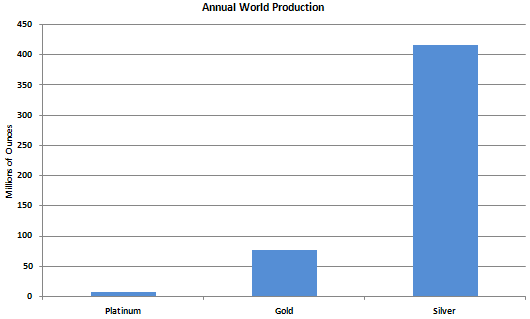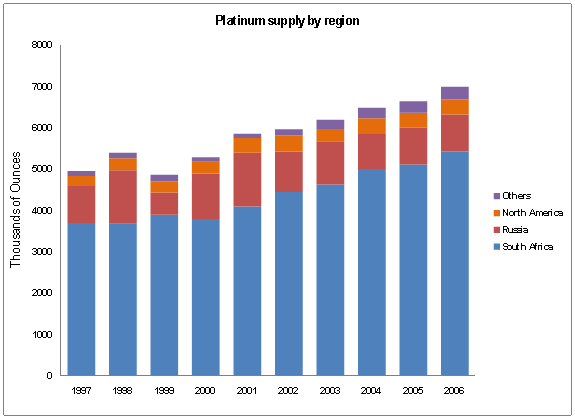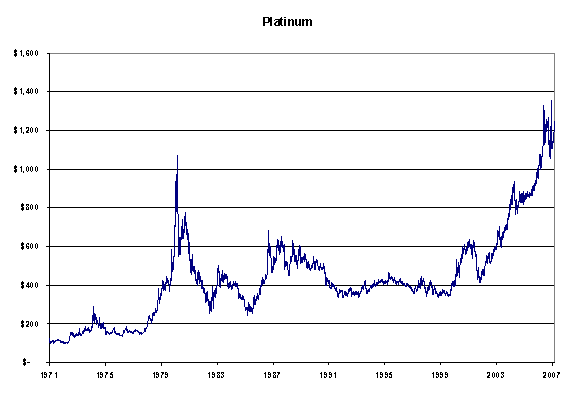Platinum – The Most Precious and Overlooked Precious Metal
Commodities / Platinum Jan 17, 2008 - 01:19 PM GMTBy: Mark_OByrne
 Why Platinum Remains a Strong Buy
Why Platinum Remains a Strong Buy
Introduction - Gold and Silver Investments Limited continue to be bullish on precious metals and bullish on platinum. Platinum has recently hit new record highs at $1590 per ounce along with gold. Even though platinum has surpassed its 1980 high of $1,070 per ounce in nominal terms, it is still only some half the price of its inflation-adjusted high of $2,800 per ounce. We believe this high will be reached in the next 5 to 8 years in this new supply/ demand driven secular bull market in platinum.
Platinum – Extremely Rare ‘Strategic Metal'
Platinum is the rarest of all precious metals. Total annual world production is about 7 million ounces, a mere 10% of the world's annual gold production of 76 million ounces. It is so rare that the US government considers it a "strategic metal" and banned its ownership and use in World War II for non-military purposes.

Growing Industrial Demand
While platinum production is only some 7 million ounces, demand for platinum has increased from about 2.6 million ounces in 1975 to more than 7 million ounces today.
Platinum demand has soared, and looks set to keep on growing through 2010, as diesel vehicles make up a bigger share of the global auto and truck fleet. Platinum demand from diesel catalytic converters is projected to hit 1.9 million ounces in 2005 and 3.3 million in 2010. Thus creating a supply demand imbalance. Platinum is an essential industrial commodity which is used worldwide in the manufacture of nearly 20% of all consumer goods. New uses are being discovered all the time. It has a resistance to corrosion, an extremely high melting point, excellent electrical conductivity, and high durability. It is a precious metal that is constantly used in new industrial applications.
Platinum has a wide variety of uses and applications in electronics, chemical processing, petroleum refining, medical and dental applications and glass dies. Significantly, it is increasingly important in environmentally friendly applications in the transport sector and increasingly needed for applications in fuel cells and other new technologies in order to combat global warming. About 1/3 of production is now used in automotive applications particularly in emission control catalytic converters.
Platinum's beautiful silver blue colour makes it in high demand for prestige jewellery which accounts for some 40% of global demand. While the high price of platinum is leading to some ‘substitution' and use of palladium and gold, the increasing wealth of some 4 billion Chinese, Indian and Asian consumers is projected to lead to increasing demand for all precious metals.

Growing Investment Demand
In recent years investment demand for platinum has also been increasing. There has been significant buying of platinum by investment funds in the last few years. Investment has not been limited to hedge funds as private investors, mutual funds and pension funds have all been increasing their commodities exposure through both futures and ETF's.
Just recently (May, 2007), Novartis, the large Swiss based multinational pharmaceutical company's pension fund announced plans to invest four percent of its 14 billion Swiss francs ($11.37 billion) in platinum and the other precious metals. They are investing some half a billion Swiss francs in each of the precious metals – 1% in each precious metal gold, silver, palladium and platinum.
Investment demand is increasing due to the recent introduction of new platinum ETFs in London and Zurich . It has been claimed that a platinum exchange-traded fund (ETF) in the US is unlikely to materialise in the near future. Platinum mining companies had been concerned that the launch of a platinum ETF in the US would result in demand outstripping supply, causing prices for the precious metal to jump considerably. Johnson Matthey said the launch of exchange-traded funds in platinum will likely "apply further upward pressure to the price".
Limited Sources of Supply
On the supply side the only meaningful deposits of platinum are found in South Africa and Russia . Importantly, 90% of total global platinum supply comes from just these two countries. These major producers are cutting back their production targets and platinum production fell last year for the first time since 1999. Demand exceeded output by 265,000 ounces, the biggest gap since 2003, according to Johnson Matthey.
Total global platinum production only represents about 6% of global gold production and less than 1% of global silver production. In addition to platinum being limited in supply it requires mining a lot of ore (8-10 tons) and it is very energy and capital intensive just to obtain one pure ounce of platinum.

There exists considerable uncertainty with regard to future supplies as there does with many finite resources. There is little available data on Russian reserves while reserves in South Africa , who are responsible for some 80% of global production, are dwindling. Political or economic problems such as strikes or nationalisation in either country may greatly affect the supply and thus price of this precious metal.
With platinum a rare metal, difficult to find and to mine, with supplies predominately in one country yet with important industrial and military applications a huge squeeze could occur if there were disruptions to South African or Russian mining production. These disruptions could come in the form of strikes or political tensions in Russia where Putin is increasingly flexing his muscles. Thus platinum is a metal that remains susceptible to supply shocks, maybe even more so than gold or silver.
Price Performance
Precious metals perform well in times of less benign economic conditions. For example in the stagflationary 1970's when there was low economic growth, rising inflation, rising interest rates and ultimately an oil crisis, precious metals and platinum, due to their counter cyclical nature, outperformed all other asset classes. Platinum went from $90 per ounce in 1971 to more than $1,000 per ounce in 1980 for a return of some 1000%. In the same period gold soared from $35 to over $850 and silver went from $2 to over $50.
How has platinum performed in recent years? It is one of the top performing asset classes and has gone from $350 in January 2000 to nearly $1,600 recently for a rise of some 350%.

Gold is up by more than 230% ($270 to over $900) and silver is up by 240% ($4.70 to over $16) in the same 8 year period.
While these returns are significant and may lead investors to fear that the best gains have passed it must be remembered that other commodities such as the grains, soft commodities and base metals are also up by far more than platinum.
The performance of oil, uranium and other base metals in recent years may be pertinent in this regard:
Oil is up from $10 to nearly $100 or 1,000% and more than 10 fold.
Zinc from $.35 to a high of $2.00, now $1.50/lb or nearly 5 fold.
Copper from $.75 to a high of $4.00, now $3.32/lb or nearly 5 fold.
Lead from $.20 to $1.60/lb or nearly 8 fold.
Nickel from $3 to $13 (high over $24/lb) or more than 4 fold.
Indium, Molybdenum, Selenium, Cobalt are all up 1000% or 10 fold and more.
Uranium has risen a phenomenal 1300% or 13 fold prior to a recent correction.
Many commodities are up between 5 and 13 fold. Platinum is only up some 350%. If platinum were to catch up with these other less rare and less precious metals, it would have to increase in value significantly.
Also it is important to remember that the Dow Jones Industrial Average rose from 1,000 in 1980 to nearly 12,000 in 1999. It was thus up nearly 12 fold in 19 years. Those who sold when the Dow Jones had risen to 4,000 in 1996 missed the most profitable phase of the bull market – the final phase of any bull market is always the most profitable.
It is important to continue to make the trend your friend in all the precious metals. Volatility will increase and there will be sharp sell offs but the medium and long term fundamentals of all the precious metals remain more than sound especially in the light of the unprecedented and deteriorating global credit, systemic and monetary crisis.
Conclusion
Since industrial and investment demand for platinum keeps growing while mine supply remains relatively fixed, the price of platinum is likely to exceed its 1980 inflation-adjusted high.
According to a study by Wainwright Economics, a respected Boston-based investment research and strategy firm, platinum is the leading indicator of inflation. It is a better inflation indicator than oil and the CRB (commodites) Index. According to David Ranson, president of Wainwright Economics, "The only asset class that is better than gold as an inflation hedge is a basket that includes silver and platinum." The precious metal component of a properly diversified portfolio should include an allocation to platinum. Full diversification within the precious metal group is important in order to reduce volatility, thereby improving performance in the entire portfolio.
At the dawn of the 21st Century precious metals are again being realised as important assets to have in a properly, holistically diversified individual or institutional portfolio. The precious metals of platinum, palladium, silver and gold are the only asset classes academically proven to have an inverse correlation to conventional assets such as stocks and property which is important in an era of record debt levels, record oil prices, increasing credit, systemic and monetary risk and increasing economic and geopolitical tension.
While platinum may be overbought in the short term, the fundamentals of platinum for 2008 point towards another deficit year in the platinum market and a continuing rise in prices seems more than likely. Platinum started 2008 at $1530 per ounce and should platinum return 30% in 2008 then it will reach the psychological level of $2,000 per ounce. - Charts courtesy of Bullion Marketing Services
How to Invest in Platinum Today
Shares in platinum mining companies can be bought but they are far more risky than owning the physical, tangible asset as mining companies have country risk. Two of the largest platinum producing countries in the world are Russia and South Africa . Mining shares also have accounting and company risk in the form of depending on the performance of employees, management and auditors and considerable risk in the form of political interference and nationalisation, environmental risk, natural disasters and mining accidents.
ETFs are a great way to speculate on prices in the short term. However, costs make them expensive for those with a medium to long term horizon. The ETF costs are not solely the 0.4% per annum compounded. There are also stamp duty charges and broker fees. And the ETF has the bid/offer spread which is generally some 0.20%. These are derivatives that track the metal price and there is counter party risk with regard to auditors, custodians and sub custodians.
Platinum Bullion is available for investment through coins and bars for delivery or in allocated accounts. Reputable dealers sell investment grade legal tender “platinum eagle” coins that contain 1 troy ounce of 0.9995 pure platinum. Australia and Canada also produce investment grade legal tender platinum coins for investors and international refineries make larger bars.
The Perth Mint Certificate Programme (PMCP) is the only government backed precious metal certificate programme in the world. The Perth Mint is Australia 's oldest operating Mint, established in 1899 and is owned by the Western Australian Government. The PMCP allows investors to own platinum bullion in unallocated or allocated accounts. There are no initial or ongoing shipping, insurance, holding or custodial fees and thus it is one of the most cost effective ways for investors to own bullion. The Perth Mint is rated AAA by S&P credit rating agency and is one of the safest and securest ways to own investment grade gold, silver and platinum bullion.
By Mark O'Byrne
www.goldassets.co.uk
Mark O'Byrne is Executive Director of Gold and Silver Investments Limited ( www.goldassets.co.uk ). He is regularly quoted and writes in the international financial media and was awarded Ireland 's prestigious Money Mate and Investor Magazine Financial Analyst of 2006.
Mark O'Byrne Archive |
© 2005-2022 http://www.MarketOracle.co.uk - The Market Oracle is a FREE Daily Financial Markets Analysis & Forecasting online publication.



